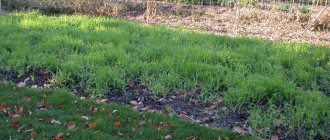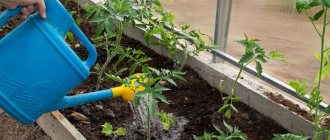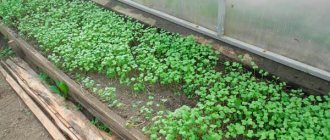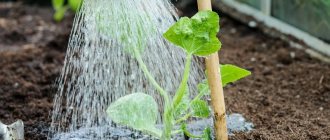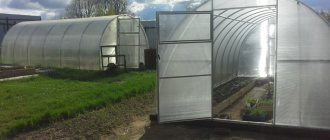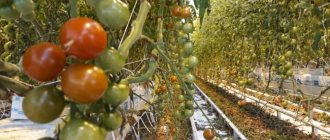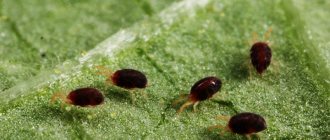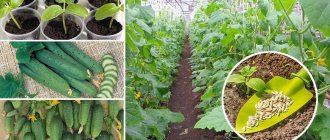You can improve soil fertility in greenhouses with the help of green fertilizers. In this case, there is no need to change, steam or disinfect the soil. Specially selected and timely sown green manure crops will help improve the structure and composition of the soil, get rid of pathogens and restore the fertile layer. To make the work of summer residents easier, I tell you what are the benefits of green manure in a greenhouse, how to do it correctly, what plants and when are best to sow.
Why plant green manure in a greenhouse?
Much is known about how to fertilize and improve the health of the soil by applying fertilizers or observing crop rotation in open ground. By the way, I have already talked in detail about how to plant and when to sow green manure on the site. But what should you do if you are used to growing vegetables in a greenhouse, repeating the established assortment of crops from year to year?
After harvesting the most common greenhouse vegetables: tomatoes, cucumbers, peppers and eggplants, which suck out most of the nutrients, the soil remains practically depleted, with the presence of various pathogens.
Owners of 2 or more greenhouses are in a much better position. In this case, it is possible to alternate them. But what if you have only one greenhouse?
What options exist for updating the soil in a greenhouse:
- replace the soil once every 3-4 years,
- or the opportunity to give the greenhouse a rest for at least a year,
- or, at worst, replacing the top soil layer,
- or its disinfection.
However, how many are ready to undertake such labor-intensive and costly activities?
An alternative, albeit with some stretch, is the use of green manure crops.
Green manure in the greenhouse:
- will help with soil fertilization,
- will disinfect it
- protect from freezing,
- will not allow weeds and pests to run wild.
Photo: green manure improves the soil both in the open ground and in the greenhouse
Choosing green manure for a future greenhouse crop
In order for plants in a greenhouse to produce a good harvest and receive the maximum of necessary microelements from the soil, without the use of chemical fertilizers, it is important to follow a certain order.
Vegetable growers with experience advise adhering to the following scheme:
- After ripening and harvesting radishes, carrots, cabbage, parsley, to regenerate the soil, sow the ridges with winter rapeseed or clover.
- The next season, sow legumes in this area.
- Immediately after harvesting legumes, prepare the soil for phacelia, buckwheat, oats or sunflower.
- In the fourth season, potatoes and tomatoes will produce an excellent harvest.
- Next, sow the greenhouse with alfalfa and sweet clover.
- Afterwards, you should plan to grow cucumbers and zucchini.
- To improve the health of the soil after pumpkin, mustard and radish are suitable.
Important! Cruciferous crops cannot be used as predecessors for existing types of cabbage. And after and before legumes, avoid planting alfalfa, spring vetch, pink clover, and white sweet clover.
Let's consider green manure plants for certain plants. Cucumbers are compatible with radish and white mustard. These green manures disinfect the soil, returning beneficial microelements that the vegetable used during its growth period. It’s a good idea to sow legumes and cereals. But vetch-oatmeal is rightfully considered a super-mixture after cucumbers. This combination will allow:
- saturate the soil with nitrogen, phosphorus, potassium;
- loosen the top layer thanks to developed roots;
- get rid of nematodes.
Eggplants, tomatoes, and peppers greatly deplete the soil. To restore the soil, it is worth sowing winter cereals in the fall. It's good if November and December are snowy. Gatherings sprinkled with snow in the greenhouse space gain protection from the cold and full hydration. Cereals provide tomatoes with potassium, which is responsible for the strong stem, juiciness and sugar content of the fruit.
The “green doctor” that rids the earth of wireworms after cultivating tomatoes is phacelia. Additionally, it saturates the soil with nitrogen and potassium, reduces acidity, and loosens it well.
You might be interested in learning how to get rid of mold in a greenhouse.
When to plant green manure in a greenhouse?
The peculiarities of sowing green manure in closed ground depend, among other things, on the type of greenhouse: a polycarbonate coating allows you to start sowing a little earlier in the spring and delay the planting in late autumn, which cannot be done under film or glass.
Sowing green manure in a greenhouse depends on:
- from the design and covering of the greenhouse,
- from a crop that bears fruit this year,
- from the crop planned for cultivation next season.
So where to start preparing greenhouses for the new season?
- First of all, you need to decide what crops you will grow under shelters this year. Based on this, further work will be carried out.
- It is also important to determine the timing of sowing future green fertilizers.
Sowing time
Sowing crops using green manure fertilizer in a greenhouse can be done at different times:
- in autumn,
- in spring,
- in summer (if necessary).
_______________________________________________________________________________
You should know that the use of green manure fertilizers will not give the greatest effect immediately, but after 2-3 years, and only if correct agricultural practices are followed.
- Make a crop planting plan for 2-3 years in advance to prevent the simultaneous placement of green manure and the main crop of the same family.
- In accordance with the timing of planting the planned main crops, select green manure crops that are suitable for the growing season and the ability to form vegetative mass and the timing of their sowing.
Photo: sowing green manure depends on the design and material of the greenhouse
When to sow green manure in spring
You can start sowing green manure in early spring, as soon as the snow melts and the ground thaws. In the greenhouse, green manure begins to be sown 6 weeks before the expected date of planting the seedlings.
The soil in the area where green manure is supposed to be sown must first be cleared of debris and weeds, and also loosened.
There are two ways to sow green manure in the spring: in rows or continuous sowing. In order for the seeds to germinate more evenly (not only in spring, but also at any other time of the year), experienced gardeners recommend mixing them with a small amount of sand or sawdust.
Sowing green manure in a greenhouse in spring
The general principles and requirements for greenhouse green manure are practically no different from similar work in open areas. However, there are also some peculiarities.
- Polycarbonate structures will allow you to start sowing at the end of February .
- In film greenhouses, these dates will shift somewhat to warmer months, not earlier than mid-March .
When to sow?
Greenhouse conditions allow sowing throughout the spring. The optimal period is considered to be April-May , although you can start much earlier, already from the end of February .
How to sow?
In comparison with autumn sowing, some features should be adhered to.
- In winter, add some snow to the greenhouse. This will greatly facilitate the work, eliminating the need for mandatory watering before sowing seeds. Thawing, the snow will provide the soil with the necessary moisture for successful seed germination.
- Loosen the soil to a depth of 5-7 cm.
- Make furrows along the entire length of the planned bed. You can also sow scattered over the surface.
- After watering (if you forgot to bring in the snow), you should sow the seeds of the future green fertilizer and sprinkle with soil.
- As soon as the green mass rises 20-30 cm above the soil surface, it needs to be cut off and dug up. The main thing is to prevent the green manure crop from flowering and inseminating.
The cut green part of the plants will quickly rot, providing the necessary nutrition for future vegetable plants.
What to sow in spring?
The most preferred spring green manures are:
- phacelia,
- oats,
- spring rape
These crops can gain rich green mass in a fairly short period of time and quickly rot after cutting, forming the necessary amount of nutrients necessary for the future harvest.
| IMPORTANT After mowing green manure plants, it is necessary to wait at least 2 weeks before planting the main crops for complete rotting. |
What are green manures?
These are varieties of plants recommended for planting vegetable and fruit crops in place. Planting green manure allows you to restore the beneficial properties of the substrate. After the green tops appear, they are cut off and the root system decomposes in the soil. Roots help saturate the soil with nitrogen and organic matter and regulate acidity.
Such measures will improve the soil structure and fight weeds and pest larvae. Often gardeners simply dehydrate the soil with regular, thorough weeding. This negatively affects crop yields. Enrichment with fertilizers does not help in this case.
Basically, green manures include perennials that grow quickly and produce green mass in two to four weeks. Their root system develops as quickly as the leaves. If you sow plants in the spring and mow them, you can mulch with the green mass or use it as fertilizer.
It is recommended to sow one of the varieties of green manure separately or use several types of plants at once. Fast-growing roots loosen the soil and saturate it with small organic debris, such as twigs or dying roots. The root system of green manure saturates the soil with moisture and air, improving its properties.
During the growth period, plants take useful substances from the soil, and green manure saturates it with nitrogen, potassium and other elements. This method of soil restoration is budget-friendly. When the green mass and roots decompose, humus is formed, which is responsible for the fertility of the substrate.
To improve the structure and properties of the soil, gardeners often use legumes (soybeans, sweet clover, alfalfa), amaranths (amaranth), buckwheat, sunflower, mustard, phacelia, rapeseed, rapeseed and other plants.
Sowing green manure in a greenhouse in the fall
In the autumn season, sowing is carried out from the end of August to the beginning of October , immediately after the full harvest.
Advantages of autumn green manure
1. Duration of stay of green manure plants in greenhouse soil
This will allow the formation of a developed root system that can sufficiently loosen the compacted soil. The long process of decomposition of green mass will increase the supply of minerals.
2. Plant protection
The greenery of winter green manure grown in spring will protect tender vegetable seedlings from possible spring frosts and serve as mulch from the spread of weeds and overheating.
3. Possibility of growing green manure twice per season
— At the end of August and beginning of September, spring crops are sown, quickly gaining green mass:
- mustard,
- phacelia,
- cereals.
— At the end of September-October the following are sown:
- winter grains,
- rape,
- phacelia.
Features of growing green manure in a greenhouse in autumn
The algorithm of actions is similar to open ground.
- First of all, it is necessary to remove all plant debris, dig up the soil, removing weeds.
- Water the areas for sowing with water and scatter the seeds evenly over the surface.
- All that remains is to lightly tap the sown areas with a flat shovel.
- If possible, it would be a good idea to sprinkle the seeds with a small layer of nutritious soil or humus.
The timing of sowing in the autumn determines whether the green manure crop will have time to accumulate a sufficient amount of green mass before frost, so that after mowing and rotting, it can provide a sufficient amount of nutrients for the future harvest. However, it is not necessary to mow green plants that have grown sufficiently; you can only trim the top part.
The main thing is to prevent flowering and the formation of seeds, otherwise, instead of benefiting, green manure will cause harm, multiplying like weeds. If the inflorescences have nevertheless formed, then you should cut off the top part of the plants, leaving the rest of the plant to rot on its own until spring, thereby fertilizing the soil.
Do you need fertilizers for green manure?
The question is, of course, interesting and timely. Mineral fertilizers in the first years will be necessary for foliar feeding. Ash is effective, providing basic crops with additional micro- and macroelements. Before flowering of the main crop, you can add nitrophoska or kemira in minimal quantities, no more than 5 g for a nightshade, pumpkin bush, 5-10 g per linear meter in the form of aqueous solutions for radishes, carrots, salads and other small crops.
To accelerate the mass germination of green manure, after sowing, the soil can be treated with biological preparations “Baikal EM-1”, “Vostok-M”. These drugs promote the proliferation of beneficial, effective microorganisms that destroy pathogenic microflora. They help green manure to clean and disinfect the soil, develop a large root system, which, when rotting, leaves microchannels that help enrich the soil with oxygen.
These preparations can be sprayed on plants during the growing season to protect against fungal and bacterial diseases. And together, green manure and biological products will ensure a good quality harvest of vegetables and other vegetable and garden crops without the use of chemicals.
Dear readers! Have you found answers to your burning questions? What else would you like to know about greenhouse greening? Share your techniques for enriching greenhouse soils with nutrients and disinfecting them in the comments to the article or on our Forum.
Sowing green manure in a greenhouse before winter
Autumn and winter sowing of green manure crops is very common. In this case, mainly winter crops are used, forming a green carpet only in the spring.
Rules for winter sowing
1. Sow winter crops
It should be noted that for late autumn sowing only those green manure crops are used that will not freeze out in winter.
1. Increase seeding rate
When sowing before winter, you should take into account the fact that a certain part of the plants may freeze out during frost. To avoid sparseness, it is worth doubling the seeding rate, or based on the number of seeds you have.
2. Don't let it bloom
Plants that have grown in the spring should not be allowed to bloom and form seeds.
3. Work green manure into the soil in advance
Green manure must be mowed in a timely manner and incorporated into the soil no later than 14 days before planting the main crop. This time will be enough for the mown leaves and stems to completely rot and obtain maximum benefit for the future harvest. _______________________________________________________________________________
Most often, winter sowing of green manure is used before planting cucumber or tomato seedlings. Often, seedlings are planted directly into a green carpet, which serves as shelter from cold weather and mulch against weeds. _______________________________________________________________________________
Is it necessary to dig up green manure in the spring?
Experienced agronomists say that burying the green mass of green manure planted in the spring improves the structure of the soil, increases its moisture capacity, water permeability and promotes the activation of microbiological processes. It is recommended to bury green manure for the garden, sown in the spring, in the ground 1-2 weeks before planting the main plants. Green manure crops must be cut or mowed before buds appear on them. If this is not done in time, they will grow a powerful root system, the plant stems will become rough, and the seeds will ripen and scatter throughout the entire dacha area. As a result, instead of benefiting the soil, you will get a new problem - weeds.
Sowing green manure in summer
Often, for additional nutrition, green fertilizers are sown additionally during the summer in the rows near cucumber plants.
- Green manure growing between cucumbers will protect them from overheating and sunburn.
- In addition, honey-bearing green manure plants will attract beneficial insects, ensuring complete pollination.
- By periodically pruning such plants after they have rotted, you can provide additional nutrition for the cucumbers.
After harvesting the cucumbers from the greenhouse to improve the health and fertilize the vacated areas, you can occupy them with any green manure.
What to sow in summer?
It is claimed that the greatest effect is achieved after sowing legumes and mustard . Cereals, incl., will successfully help restore soil after cucumbers. winter crops But the best effect is obtained after a combination of green manure.
There is no competition here, according to reviews from experienced gardeners, a mixture of vetch and oats , which, in addition to nutrition in the form of the main macroelements: nitrogen, phosphorus and potassium, will get rid of nematodes.
Photo: green manure mixture
How to choose green manure for spring planting
Before sowing, the gardener is not recommended to select plant varieties that belong to the same family with the main plantings, that is, colza should not be planted before planting beets, etc. You cannot plant the same green manure in the same place every year.
Its varieties should alternate. For clay soil, plants belonging to the grass family are recommended. They will loosen the soil well. The planting should be processed and mowed before flowering. Maximum allowed development cycle: budding.
In the spring, you can sow oats, sweet clover or lupine in place of planting potatoes, pumpkins or peppers. Radish and mustard are suitable for beets or beans. Before planting corn, it is recommended to plant spring rape or phacelia. Before choosing green manure, you should consider the type of soil. The selected plant improves the structure of the substrate and saturates the soil with useful substances. Sowing green manure will help regulate the number of weeds.
For poor, dense soil, vetch with oats or rye or mustard is suitable. They will loosen the soil and improve the yield of main crops. To disinfect the soil from rot and scab, the beds are sown with rapeseed, legumes, radish and mustard. For an area infested with wireworms, lupine, sweet clover, rapeseed or phacelia are suitable. For dry, dehydrated soil, planting phacelia or rapeseed is recommended.
When the substrate is subject to erosion, plants of the cruciferous family, radishes, are sown. If groundwater is close and the plant itself is waterlogged, then lupine will be the best. To enrich with nitrogen, legume green manure or cereal plants should be sown. All species can be planted alone or in a mixture.
In autumn and spring, you can plant white mustard as green manure. Planting should not be done in late spring or summer. White mustard should be planted before planting tomatoes and peppers. Green manure does not need to be harvested from a potato field. For other root vegetables, oilseed radish is suitable. Phacelia should be planted before planting tomatoes and strawberries.
Growing technology
In autumn, the soil is enriched with organic matter and mineral additives. After this, the bed needs to be dug up. After the snow has melted, it is necessary to begin sowing green manure. All blocks of earth in the plot must be broken up with a rake. There are two methods for sowing plants. The first method is to sift over the surface of the bed. The seeds are raked from above. The second method is to cut furrows with a hoe to a depth of four to seven centimeters. Then they sow the seeds and cover them with soil.
The top of the bed must be mulched or covered with spruce branches. Green manure needs to be mowed before budding or a couple of weeks before planting the main crop. Wide-row sowing is possible. The intervals between rows are 15 centimeters. Then they form a row for seedlings. And again they plant two rows of green manure.
But when planting, green manure must be cut off before flowering. The green mass can be used to mulch the bed itself or until the main crop is planted, it can be embedded in the ground. When rotting, the soil is saturated with useful substances. Green manure can fully replace fertilizers.
The influence of plants on the soil
Green manure has a positive effect on air and moisture permeability. They stop erosion of the substrate. These cultures have a positive effect on its acidity and structure. To prevent the site from becoming empty, green manure should be planted after harvesting the main crops. For light sandy soil and dense soil, legumes are used.
Plants loosen the soil and saturate it with nitrogen. They act like manure. Cereal plants are more versatile. They enhance water resistance and saturate the soil with potassium and nitrogen. They work best in acidic soil. They prevent the weed root system from developing fully.
It is not recommended to plant cruciferous green manure in beds if the substrate has high acidity. They improve the structure of any type of soil. This type of plant quickly grows green mass, and its roots loosen the ground. They prevent phosphorus from leaching out. This element begins to be more easily absorbed.
Rapeseed does not like to grow on soil that is too wet or in soil with a poor composition. This is the most capricious green manure. After planting radishes, rapeseed or mustard with cabbage, the heads of cabbage may not set.
If it is necessary to destroy weeds and pathogenic bacteria, then hydrophilic plants should be planted. They increase breathability and reduce acidity. Buckwheat green manure has a similar effect. They additionally enrich the earth with potassium and phosphorus. Amaranth green manure enhances the productivity of cultivated crops.
Landing dates
Mustard should be sown from spring to autumn. In spring, they are planted after the snow has melted. The ripening period is from one and a half to two months from the date of planting. After mowing the mustard, the main crop is sown after eight weeks. The plant quickly grows green mass and controls the growth of weeds. In summer, mustard is usually sown with tomatoes and eggplants.
Mustard can be combined with potato plantings. With its help you can fight scab. For planting “in winter” the procedure is carried out in September. The tops don’t even need to be buried in the ground. Sowing is carried out in rows with an interval of 10 to 15 centimeters.
Phacelia helps increase the yield of vegetables and berries. The plant is unpretentious and has a decorative appearance. Planting is carried out in the spring months after the snow melts and the soil warms up. Phacelia grows in peat, sandy and clay soil. After planting green manure, the soil becomes looser and less acidic.
The plant attracts insects for pollination, suppresses the development of fungal diseases and bacteria. It prevents aphids, nematodes, and wireworms from multiplying. Mow the phacelia 45–50 days after planting. You can also not mow the green manure. It will protect crops from frost and strong winds.
Well-moistened soil with a low acidity level is suitable for clover. This green manure enriches the soil with minerals, loosens it and saturates it with oxygen. It is recommended to plant clover in the ground before flowering. It is best to do this during budding. It is in the buds that a large amount of nitrogen is found.
With the help of the plant, a humus layer is quickly formed and fertility increases. It is not recommended to sow it on acidic or salty soil. Optimal planting time: from March to April. In summer, the planted area is regularly watered. Two weeks after mowing, it is recommended to plant tomatoes, cucumbers or eggplants in its place. Legumes should not be planted after clover.
Special bacteria live in the roots of lupine, transferring nitrogen from the deep layers of the earth to the upper ones. It absorbs phosphate compounds, loosens the soil in the beds, and deoxidizes the soil. Before using green manure, you need to consider the type of soil.
For lupine with white flowers, loam or soil with a sandy composition is suitable. With purple flowers, the substrate should be more acidic. For lupine with yellow flowers, abundant regular watering. Sowing time: first ten days of May. After six to eight weeks, it’s time to mow the greens. They do this until the stems begin to become coarse. After mowing, the lupine is embedded in the ground.
Oats, like all green manure cereals, saturate the soil with organic matter, phosphorus and potassium. To enrich the substrate with nitrogen, it is recommended to use a mixture of oats with peas or spring vetch. This cereal is suitable for sandy soil and dense, oily black soil.
Its properties resemble manure. The roots of the cereal loosen the soil and help saturate it with moisture and oxygen. They prevent soil erosion and improve moisture absorption by main crops. The root system contains substances that suppress rot pathogens, fungal infections, and pathogenic bacteria. Best time for sowing: April. In autumn, you can sow oats in the first ten days of September.
Currently reading:
- How to grow Chinese cabbage in open ground
- Choosing cucumbers for open ground according to your preferences
- Using hydrogel in open ground for plants
- Planting to decorate the site with three types of coniferous trees
Share the news on social networks
About the author: Vladimir Petrovich Efremov
Chief agronomist of the limited liability company “Association of Peasant (Farm) Farms “Kuznetsovskaya””, Ilovlinsky district of the Volgograd region.
What kind of green manure should I sow in a greenhouse?
In general, the choice of green manure for greenhouse farming is extensive.
| The main requirement is that the subsequent main crop and green manure must belong to different families |
Mustard
Mustard is very popular for sowing in a greenhouse, successfully increasing the green mass even before the onset of frost, thereby protecting the soil from weeds and pests.
It does not need complete mowing if it has not grown to the seed stage. In this case, you can mow down the greens a little by cutting off the inflorescences, leaving the main plants to rot on their own.
This crop is good for sowing in winter and spring. All that remains is to wait for the early shoots and plant them in the soil, again no later than 2 weeks before placing the vegetable seedlings there.
Oats and phacelia
Often found as green manure in a greenhouse, oats are sown in September and have formed enough green mass before frost. AND
The favorite option for green manure among experienced summer residents is phacelia.
Green manure mixture
The greatest benefit will come not from a monosideral crop, but from a mixture of different seeds.
The composition of green manure can be completely different:
- soy + oats,
- vetch + oats,
- peas + oats, etc.
It doesn’t really make sense to choose one specific type of green manure in a greenhouse for a specific crop. Everyone benefits. But a mixture of different types can significantly increase their effectiveness.
Surely, your more experienced neighbors in the country have already found their optimal combination. Get some advice. I’m sure you will be offered many proven recipes. ______________________________________________________________________________
Read more about the rules of cultivation and types of green manure in this article
Main green manure plants
What plants can be used as green manure? As a rule, representatives of the Cruciferous, Legume, and Cereal families. In general, about 400 plant species can be green manures.
Green manure table for vegetables
Main plant species by family.
- Legumes are the best suppliers of nitrogen. These are peas, beans, alfalfa, clover, lupine.
- Grains are the best way to control weeds and replenish biomass. Suitable for greenhouses: oats, wheatgrass, rye, barley.
- Cruciferous vegetables - disinfect the soil and help fight weeds. These are mustard, rapeseed, radish, rapeseed.
The best types of green manure
Advice! Mustard planted in a potato field will ensure a good supply of nutrients and thereby reduce fertilizer consumption.
White mustard is one of the most common green manures
Table. Main types of green manure.
| View | Family | Description |
| Mustard | Cruciferous | Perhaps this is the most popular green manure that can be used on any site, as well as in a greenhouse. The only limitation is that mustard is not used as a precursor for other cruciferous vegetables. It helps to overcome weeds, enriches the soil with organic matter, protects the soil from erosion, and fights pests and pathogens. Mustard grows well and is unpretentious to growing conditions. As a rule, it is planted in early spring (early March) - it is able to germinate at air temperatures just above zero and does not need particularly warm weather to grow. By the time it’s time to plant seedlings in the greenhouse, the mustard will have time to grow a decent amount of green mass. And tomatoes can be planted without even removing the mustard itself. |
| Rye | Cereals | The most unpretentious and undemanding green manure crop, but working with the crop is difficult. Rye is not afraid of drought, tolerates cold well, grows quickly, and fights well against midge, sow thistle and other weeds. This plant is an excellent opponent of nematodes and fungal infections. That is why it is often used to improve the condition of the soil and treat it. It is good to sow rye after harvesting tomatoes in the greenhouse. But the crop is difficult to process; most often it is simply buried in the ground. It is also mowed in the spring and sometimes used to mulch beds. |
| Phacelia | Borage | It is usually planted as soon as the snow melts or in the fall before frost, because it is very cold-resistant. It grows very quickly, is not picky about soils - on the contrary, it will improve the condition of any soil, significantly increasing its fertility and loosening it well. It is an excellent predecessor plant for any garden crop. Phacelia is also a very beautiful plant and often replaces flowers. |
| Beans | Legumes | This is the best source of nitrogen for the soil and an excellent substitute for manure. Beans are a good neighbor for tomatoes, which is why they are often planted in the greenhouse at the same time. The green mass of the plant is impressive; in the fall it is buried in ridges along with the roots. However, beans are quite expensive green manure. |
| Oilseed radish | Cruciferous | A fast-growing green manure that grows a huge green mass in 1.5-2 months. Radish is an excellent weed fighter and easily copes with various plant diseases and insects. The above-ground part is dug up a month after the emergence of seedlings. |
| Mouse peas (vetch) | Legumes | Mouse peas grow quickly and are often used as an intercrop between planting seasons of other plants. It is good to use it where tomatoes, eggplants, and peppers will be grown. You can plant mouse peas at any time of the year from the moment the first warm days set in (plus temperatures). It provides an excellent composition of vermicompost and is a nitrogen supplier. |
| Oats | Cereals | It is used less frequently than rye, but is an even better green manure - oats are not so capricious to growing conditions and grow almost anywhere. It loosens the soil perfectly and lifts minerals into the upper layers of the earth. It is sown in early spring. Best suited for preparing soil for potatoes. |
| Sweet clover | Legumes | A biennial that is usually grown as an annual. It is hardy, not afraid of bad conditions, and grows very quickly. It is an excellent source of nitrogen, and you won’t have to dig up the soil after it, because the root system of sweet clover is very powerful and branched. The root system of this plant is considered to be the most useful. It is also very important not to let the sweet clover grow, otherwise the stems will become very thick. |
| Rape | Cruciferous | It is a precursor for tomatoes, eggplants, and peppers. Rapeseed is sown closer to autumn, at the end of August, so that it does not have time to outgrow (the fact is that such plants can get sick). This crop is capricious, does not like moisture, severe cold, and is susceptible to root rot, but it perfectly loosens dense, heavy soils. |
For greenhouses, mustard is considered the best green manure because it has the necessary properties, grows quickly, and disinfects the soil. Tomatoes can be planted in holes made directly between mustard bushes. The main thing is that the bushes are not higher than 20-30 cm.
You can also plant rye or oats in the greenhouse. This is done immediately after harvesting in the fall. As soon as snow falls, the rye seedlings need to be sprinkled with snow, but this is not necessary.
What to sow in a greenhouse for tomatoes and cucumbers?
What green fertilizers to choose before and after growing tomatoes and cucumbers in a greenhouse?
In general, it is believed that since cucumbers and tomatoes are grown in greenhouses in the vast majority of cases, almost any green manure can be grown, because they all belong to different families.
Green manure will fill the potassium deficiency
In the fall, it will be most useful to sow the vacated area with winter cereals . Before frost, the emerging shoots should be covered with snow to prevent freezing.
Cereals will supply the soil with potassium, which is so necessary for nightshades and cucumbers. Its deficiency is often the main reason for delayed flowering and low fruit set.
- legumes , cruciferous vegetables or phacelia will be excellent to use .
- Excellent results were noted when greening with a mixture of various crops.
Green manure will disinfect the soil
It is important to remember that if part of your greenhouse was occupied by tomatoes, then with a high degree of probability it can be said that late blight pathogens have accumulated in the soil. This fact should be taken into account when choosing a future green fertilizer.
- In this case, there will be great benefit from placing mustard , phacelia or oilseed radish , which, in addition to cleansing late blight, will also provide the plants with available nitrogen.
- For disinfection, it would be useful to sow alfalfa , as well as rye .
Especially for cucumbers
Owners of greenhouses in which they plan to grow cucumbers should take into account some of the biological characteristics of this crop.
Having a very underdeveloped root system, cucumber plants cannot obtain food from deep layers of soil. Nutrition occurs by absorbing nutrients only from the top soil layer, which must be very fertile.
Almost all recommended green manure plants can cope with this task. However, it is still advisable to use crops that quickly form vegetative mass , which will help to obtain maximum benefit from its decomposition.
Functions of green manure
As a rule, slightly grown green manure (at the beginning of flowering or even before the beginning of this period) is simply plowed into the soil, thereby introducing completely natural fertilizers into it. Thus, natural compost is created, which protects the soil from various types of erosion, and when decomposing, enriches it with proteins, nitrogen, starch, sugars and other substances. Due to the rather strong, powerful, branched roots of helper plants, the soil becomes looser or, on the contrary, compacted (depending on its structure), and beneficial worms and microbes are also attracted to the site, which process them and, again, loosen the soil. Also, the roots of “green fertilizers” are also suppliers of useful substances from the depths of the soil to its top layer.
Phacelia green manure
On a note! By rotting, the roots create unique microchannels in the soil, through which the water and air that plants need so much penetrate.
The green manure plants themselves grow quite quickly, creating a powerful green part, thanks to which light-loving weeds are constantly in the shade and die from lack of light. Also, certain species of these plants secrete certain substances that can inhibit the growth of seeds - this also helps to reduce the amount of weeds. Green manure plants, growing among garden crops, are capable of diverting some of the pests to themselves, thereby protecting your work. And some are even able to scare them away and drive them away from the site - for example, nematodes are afraid of radishes.
Crop rotation scheme
Green manures are also assistants in pollination. Their flowers and pollen are attractive to pollinating insects: bumblebees and bees will constantly hover over them, simultaneously pollinating neighboring plants. And a good harvest largely depends on high-quality pollination.
Green manure also helps in pollination
Don’t forget about nitrogen-fixing bacteria - they are well known to everyone from biology lessons. If you plant green manures belonging to the legume family, then thanks to them the soil will be significantly enriched with nitrogen available to other plants (this is about 50% of the total amount of the element found in the green manure plant).
To summarize, let’s consider what main functions green manures perform.
- “Green fertilizers” significantly increase the percentage of biomass in the soil.
- These plants provide rapid formation of humus.
- Legume green manures are excellent suppliers of nitrogen for cultivated plants.
- Green helpers improve soil structure, help better absorb and retain moisture, and provide excellent aeration.
- Green manure provides the exchange of substances in the upper and deeper layers of the soil.
- Helper plants fight weeds, pests, and diseases.
- Green manures are excellent soil protectors from erosion, and they also help pollinate other plants.
- These crops are able to regulate soil acidity/alkalinity.
Of course, you shouldn’t hope that green manure will change the soil on your plot or in a greenhouse in just a year. But the results of working with them will already be noticeable next season.
Mustard - green fertilizer
Green manure for cucumbers
Cucumbers absorb nutrients from the surface layer of soil, so it is important that it is fertile. Almost any green manure will help you cope with this task: phacelia, barley, oats, peas, vetch, rapeseed, etc. The listed green manures can be sown in the summer between rows. This will significantly improve the taste of greens.
But it is not advisable to sow rye in front of cucumbers. According to observations, it not only suppresses weeds, but after it the cucumbers develop worse than usual.
Green manures sown after cucumbers
When the harvest of greenhouse cucumbers is harvested, it is best to sow legumes to replace them - peas, beans or broad beans. They will restore soil fertility and enrich it with nitrogen.
We hope you are convinced that green manure in the greenhouse in the fall is simply necessary. Reviews from summer residents who actively sow oats, mustard, phacelia and other plants indicate that this is a useful and effective task. Try sowing green fertilizers in your greenhouse!
You will find more information about green manure in the articles:
- Green manure: secrets of using green fertilizers
- What green manures can be sown in the fall after harvesting?
- What are the best green manures to sow in the garden and greenhouse in the spring?
- The best green manure for the garden: how to sow and when to plant it in the soil
How and when to bury green manure
Is it necessary to plow green manure?
Green manure crops sown in winter are not harvested in the fall. Before the onset of cold weather, they manage to develop a strong root system and build up a leafy ground mass 10 centimeters or more in height. But sometimes it happens that seedlings do not have time to appear before winter. There is nothing wrong with this: the sprouts will appear in the spring and quickly grow.
Some professionals believe that plowing or burying green manure disrupts the structure of the soil, and recommend cutting them with a flat cutter at a depth of 5 cm and using them as mulch, spreading them over the bed. Gradually, this green manure mulch, releasing nitrogen, turns into compost, and the roots remaining in the ground rot and, with the help of microorganisms and earthworms, become humus.
When to plow green manure
Green manure, sown continuously in the fall, is harvested and plowed in the spring, three weeks before planting or sowing the main crop. However, you need to keep in mind that in acidified areas and deprived of humus, all the green mass will not have time to be processed before sowing vegetables and will simply rot in the ground, so only part of the mowed grass is buried, and the rest is added to a compost pit or left on the surface of the area in the form of mulch , which will speed up the process of decomposition of green manure roots. And after 2-4 weeks, it will be possible to sow or plant early garden crops in this area.
If you sowed green manure in rows (curtains) in the fall, in the spring cut the ground mass with a flat cutter or cultivator, throw it into the rows and close it up, and after 2-3 weeks proceed to sowing or planting the main crop.
Green manure sown in early spring is mowed two weeks after emergence and buried in the soil. The earliest sown green manures have time to completely decompose in the ground by May. You can plant or sow the main crop 2-3 weeks after plowing in green manure.
Do not forget that you need to mow green manure at the beginning of flowering or as soon as they begin to form buds.
Green manure for tomatoes
There are not many plants growing in the greenhouse in the middle zone, mainly cucumbers, tomatoes and peppers. Therefore, the use of green manure will be a real salvation for impoverished soil. Before planting tomato seedlings, you can sow any legumes, cruciferous vegetables or green manure grains. The most ideal option is phacelia. You can also sow: vetch, alfalfa, lupine, oats, buckwheat, goat rue. The use of these green manures will increase the tomato yield by at least 30%! In addition, pests will not be afraid of seedlings.
